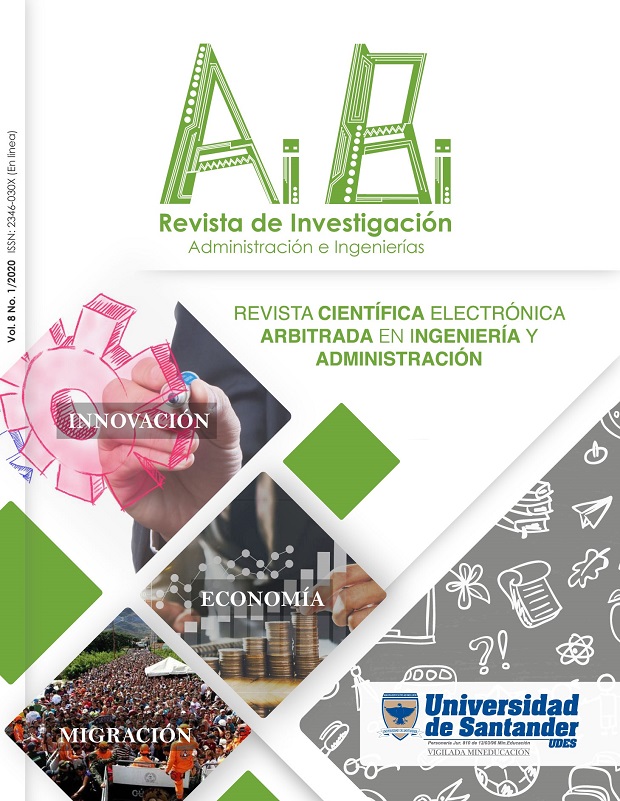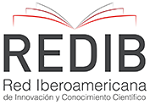Caracterización de la tasa de liberación de calor en los cilindros de un motor de generación a gas natural de 2 MW.
DOI:
https://doi.org/10.15649/2346030X.581Palabras clave:
tasa de liberación de calor, motor de generación, gas natural, cámara de combustión, modelizado de valor medioResumen
Desarrollar modelos matemáticos para los motores de generación de energía más confiables que permitan proponer un uso eficiente de los combustibles y aumentar la eficiencia de conversión energética, se ha convertido en uno de los principales objetivos de los trabajos de investigación en el área. Con el fin de estudiar el fenómeno liberación de calor en los cilindros de un motor a gas natural J612 Jenbacher de 2 MW a partir de variables medias disponibles en registros operacionales, se ha propuesto un modelo semifísico a partir de balances de masa, energía, ecuaciones constitutivas y regresiones estadísticas. Los resultados muestran que a partir del modelo propuesto del calor rechazado con un coeficiente de determinación de 0.99, el permiten alcanzar un error relativo máximo de 2% en modo isla y del 4% operando en red para la estimación de la temperatura de los gases a las salidas de los cilindros. Así mismo, el modelo permite determinar la fracción de calor perdido en los cilindros en función de la energía aportada por el gas natural.
Referencias
S. Broekaert, J. Demuynck, T. De-Cuyper, M. De-Paepe y S. Verhelst, “Heat transfer in premixed spark ignition engines part I : Identi fi cation of the factors in fl uencing heat transfer,” Energy, vol. 116, pp. 380–391, 2016.
B. Deng, J. Fu, D. Zhang, J. Yang, R. Feng y J. Liu, “The heat release analysis of bio-butanol / gasoline blends on a high speed SI (spark ignition) engine,” vol. 60, pp. 230–241, 2013.
S. Backlund, P. Thollander, J. Palm y M. Ottosson, “Extending the energy efficiency gap,” Energy Policy, vol. 51, pp. 392–396, 2012.
D.R. Johnson, R. Heltzel, A.C. Nix, N. Clark y M. Darzi, “Greenhouse gas emissions and fuel e ffi ciency of in-use high horsepower diesel, dual fuel , and natural gas engines for unconventional well development,” Appl. Energy, vol. 206, no. September, pp. 739–750, 2017.
S. Jain, S. Kalambe, G. Agnihotri y A. Mishra, “Distributed generation deployment : State-of-the-art of distribution system planning in sustainable era,” Renew. Sustain. Energy Rev., vol. 77, no. February, pp. 363–385, 2017.
T. Ackermann, “Distributed generation : a definition,” vol. 57, pp. 195–204, 2001.
A. Amell, D.B. Olsen y G.J. A. Diaz, “Strategies to improve the performance of a spark ignition engine using fuel blends of biogas with natural gas , propane and hydrogen,” pp. 1–11, 2018.
“BP Statical Review of World Energy,” vol. 67, p. 56, 2018.
G. Borman y K. Nishiwaki, “Internal-combustion engine heat transfer,” Prog. Energy Combust. Sci., vol. 13, no. 1, pp. 1–46, 1987.
G.M. Kosmadakis, E.G. Pariotis y C.D. Rakopoulos, “Heat transfer and crevice flow in a hydrogen- fueled spark-ignition engine : Effect on the engine performance and NO exhaust emissions,” Int. J. Hydrogen Energy, vol. 38, no. 18, pp. 7477–7489, 2013.
C. Hong, N. Jimin, Y. Nianye y S. Xiuyong, “Study on the Platform of Engine Product Development,” vol. 16, pp. 211–217, 2011.
T. Shudo y H. Suzuki, “Applicability of heat transfer equations to hydrogen combustion,” JSAE Rev., vol. 23, no. 3, pp. 303–308, 2002.
W. Nußelt, “Der Wärmeübergang in der Verbrennungskraftmaschine. VDI-Forsch.” Heft, 1923.
V.K. Elser, “Forschung,” no. I, 1955.
T. and F.M. Group y W.J.D. Annand, “Heat transfer in the cylinders of reciprocating internal combustion engines,” Proc. Inst. Mech. Eng., vol. 177, no. 1, pp. 973–996, 1963.
G. Woschni, “A universally applicable equation for the instantaneous heat transfer coefficient in the internal combustion engine,” SAE Technical paper, 1967.
G. Woschni, “Die Berechnung der Wandverluste und der thermischen Belastung der Bauteile von Dieselmotoren,” MTZ, vol. 31, p. S-491, 1970.
J.A. Gatowski, E.N. Balles, K.M. Chun, F.E. Nelson, J.A. Ekchian y J.B. Heywood, “Heat release analysis of engine pressure data,” SAE Technical paper, 1984.
G.F. Hohenberg, “Advanced approaches for heat transfer calculations,” SAE Technical paper, 1979.
S. Broekaert, T. De Cuyper, M. De-Paepe y S. Verhelst, “Experimental investigation of the effect of engine settings on the wall heat fl ux during HCCI combustion,” Energy, vol. 116, pp. 1077–1086, 2016.
T. De Cuyper, S. Broekaert, K. Chana, M. De Paepe, and S. Verhelst, “Evaluation of empirical heat transfer models using TFG heat flux sensors,” Appl. Therm. Eng., vol. 118, pp. 561–569, 2017.
J. Demuynck, M. De-Paepe, H. Huisseune, R. Sierens, J. Vancoillie y S. Verhelst, “On the applicability of empirical heat transfer models for hydrogen combustion engines,” Int. J. Hydrogen Energy, vol. 36, no. 1, pp. 975–984, 2010.
T. De-Cuyper, J. Demuynck, S. Broekaert, M. De-Paepe y S. Verhelst, “Heat transfer in premixed spark ignition engines part II : Systematic analysis of the heat transfer phenomena,” Energy, vol. 116, pp. 851–860, 2016.
H. Hassan, “Unsteady heat transfer in a motored IC engine cylinder,” Proc. Inst. Mech. Eng., vol. 185, no. 1, pp. 1139–1148, 1970.
D.J.O. Nijeweme, J.B.W. Kok, C.R. Stone y L. Wyszynski, “Unsteady in-cylinder heat transfer in a spark ignition engine: experiments and modelling,” Proc. Inst. Mech. Eng. Part D J. Automob. Eng., vol. 215, no. 6, pp. 747–760, 2001.
J. Martín, “Aportación al diagnóstico de la combustión en motores Diesel de inyección directa,” Editor. Univ. Politécnica Val. Val. Spain, 2007.
O.A. Vergel y F.P. González, Diagnóstico experimental del proceso de combustión en motores Diesel de inyección directa. Universidad Politécnica de Valencia, 1998.
M. Lapuerta, O. Armas y J.J. Herna, “Diagnosis of DI Diesel combustion from in-cylinder pressure signal by estimation of mean thermodynamic properties of the gas,” vol. c, pp. 513–529, 1999.
P. Schihl, J. Tasdemir, E. Schwarz y W. Bryzik, “Development of a zero-dimensional heat release model for application to small bore Diesel engines,” SAE Technical Paper, 2002.
C.D. Rakopoulos, “Validation and sensitivity analysis of a two zone Diesel engine model for combustion and emissions prediction,” vol. 45, pp. 1471–1495, 2004.
J. Ghojel y D. Honnery, “Heat release model for the combustion of diesel oil emulsions in DI diesel engines,” vol. 25, pp. 2072–2085, 2005.
F. Payri, P. Olmeda, J. Martín y A. García, “A complete 0D thermodynamic predictive model for direct injection diesel engines,” Appl. Energy, vol. 88, no. 12, pp. 4632–4641, 2011.
M. Baratta, A.E. Catania, A. Ferrari, R. Finesso y E. Spessa, “Premixed-diffusive multizone model for combustion diagnostics in conventional and PCCI diesel engines,” J. Eng. Gas Turbines Power, vol. 133, no. 10, p. 102801, 2011.
J. Karlsson y J. Fredriksson, “Cylinder-by-cylinder engine models vs mean value engine models for use in powertrain control applications,” SAE Technical Paper, 1999.
L. Guzzella y C. Onder, Introduction to modeling and control of internal combustion engine systems. Springer Science & Business Media, 2009.
N. Xiros, Robust control of diesel ship propulsion. Springer Science & Business Media, 2012.
E. Hendricks y S.C. Sorenson, “Mean Value Modelling of Spark Ignition Engines,” SAE Trans., vol. 99, pp. 1359–1373, 1990.
E. Hendricks y S.C. Sorenson, “SI engine controls and mean value engine modelling,” SAE Technical paper, 1991.
M. Müller, E. Hendricks y S.C. Sorenson, “Mean value modelling of turbocharged spark ignition engines,” SAE Technical Paper, 1998.
M. Fons, M. Muller, A. Chevalier, C. Vigild, E. Hendricks y S.C. Sorenson, “Mean value engine modelling of an SI engine with EGR,” SAE technical paper, 1999.
S.B. Choi y J.K. Hedrick, “An observer-based controller design method for improving air/fuel characteristics of spark ignition engines,” IEEE Trans. Control Syst. Technol., vol. 6, no. 3, pp. 325–334, 1998.
P. Moraal y I. Kolmanovsky, “Turbocharger modeling for automotive control applications,” SAE Technical Paper, 1999.
A. Chevalier, M. Müller y E. Hendricks, “On the validity of mean value engine models during transient operation,” SAE Trans., pp. 1571–1592, 2000.
A. Chevalier, C.W. Vigild y E. Hendricks, “Predicting the port air mass flow of SI engines in air/fuel ratio control applications,” SAE Trans., pp. 183–210, 2000.
L. Eriksson, “Modeling and control of turbocharged SI and DI engines,” Oil Gas Sci. Technol. l’IFP, vol. 62, no. 4, pp. 523–538, 2007.
X. Jiao y T. Shen, “Lyapunov-design of adaptive air-fuel ratio control for gasoline engines based on mean-value model,” in Control Conference (CCC), 2011 30th Chinese, 2011, pp. 6146–6150.
G. Theotokatos, “On the cycle mean value modelling of a large two-stroke marine diesel engine,” Proc. Inst. Mech. Eng. Part M J. Eng. Marit. Environ., vol. 224, no. 3, pp. 193–205, 2010.
G. Theotokatos, C. Guan, H. Chen y I. Lazakis, “Development of an extended mean value engine model for predicting the marine two-stroke engine operation at varying settings,” Energy, vol. 143, pp. 533–545, 2018.
K. Nikzadfar y A.H. Shamekhi, “An extended mean value model (EMVM) for control-oriented modeling of diesel engines transient performance and emissions,” FUEL, vol. 154, pp. 275–292, 2015.
F. Maroteaux y C. Saad, “Combined mean value engine model and crank angle resolved in- cylinder modeling with NOx emissions model for real-time Diesel engine simulations at high engine speed,” Energy, vol. 88, pp. 515–527, 2015.
F. Baldi, G. Theotokatos y K. Andersson, “Development of a combined mean value – zero dimensional model and application for a large marine four-stroke Diesel engine simulation,” Appl. Energy, vol. 154, pp. 402–415, 2015.
P.J.M. Schulten y D. Stapersma, “Mean value modelling of the gas exchange of a 4-stroke diesel engine for use in powertrain applications,” SAE Technical Paper, 2003.
A. Shamekhi y A.H. Shamekhi, “Expert Systems with Applications A new approach in improvement of mean value models for spark ignition engines using neural networks,” Expert Syst. Appl., vol. 42, no. 12, pp. 5192–5218, 2015.
C. Sui, E. Song, D. Stapersma y Y. Ding, “Mean value modelling of diesel engine combustion based on parameterized finite stage cylinder process,” Ocean Eng., vol. 136, no. 145, pp. 218–232, 2017.
B.A.P. Campos, L.T. Lucio, R. Reginatto, F.S. Marques, J.C.C. Zank y T.J.L. de Franca, “Biogas fueled internal combustion engine Mean Value Model for distributed generation,” in 2018 Simposio Brasileiro de Sistemas Eletricos (SBSE), 2018, pp. 1–6.
Z. Han y R.D. Reitz, “A temperature wall function formulation for variable-density turbulent flows with application to engine convective heat transfer modeling,” Int. J. Heat Mass Transf., vol. 40, 1997.
A. Jafari y S.K. Hannani, “Effect of fuel and engine operational characteristics on the heat loss from combustion chamber surfaces of SI engines B,” vol. 33, pp. 122–134, 2006.
S. Šarić y B. Basara, “A hybrid wall heat transfer model for IC engine simulations,” SAE Int. J. engines, vol. 8, no. 2, pp. 411–418, 2015.
S. Šarić, B. Basara y Z. Žuni, “International Journal of Heat and Fluid Flow Advanced near-wall modeling for engine heat transfer,” vol. 63, pp. 205–211, 2017.
O. Armas, “Diagnóstico experimental del proceso de combustión en motores Diesel de inyección directa,” Universidad Politécnica de Valencia, 1998.
Descargas
Publicado
Cómo citar
Número
Sección
Altmetrics
Descargas
Licencia
La revista ofrece acceso abierto bajo una Licencia Creative Commons Attibution License

Esta obra está bajo una licencia Creative Commons Attribution (CC BY 4.0).












